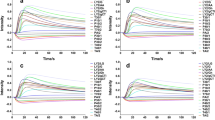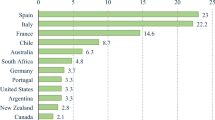Abstract
Flavor acceptability is an important aspect of evaluating the quality of food products. Rapid flavor measurements and the detection of unsatisfactory products are thus necessary for the quality control of yogurt. To better evaluate the flavor acceptability of yogurt, this study used a method based on an electronic nose and nonlinear chemometric back-propagation neural network (BPNN) and random forest (RF) models. Initially, principal component analysis was applied to visualize the quality distribution of a set of yogurt samples, but it failed to distinguish between the satisfactory and unsatisfactory samples. However, the BPNN and RF models clearly discriminated between the two sample types, with accuracy values close to 100%. The RF model achieved better discrimination than the BPNN model, with an accuracy of 93.75% for three subsets of the samples with unsatisfactory flavor. In summary, the combination of an electronic nose and a nonlinear chemometric model is an effective system for the assessment of yogurt flavor acceptability.









Similar content being viewed by others
Change history
29 April 2020
The original version of the article unfortunately contained an error in one of the affiliations of the first author, Dr. Huaixiang Tian. The institution name was incorrectly published as ���State Key Laboratory of Technology��� and the corrected name is ���State Key Laboratory of Dairy Biotechnology���.
References
Z. Wei, W. Zhang, Y. Wang, J. Wang, J. Food Eng. 203, 41–52 (2017). https://doi.org/10.1016/j.jfoodeng.2017.01.022
C. Hefa, J. Crit. Rev. Food Sci. 50, 938–950 (2010). https://doi.org/10.1080/10408398.2013.814044
S. Ozturkoglu-Budak, C. Akal, A. Yetisemiyen, J. Dairy Sci. (2016). https://doi.org/10.3168/jds.2016-11217
S. Xu, T.D. Boylston, B.A. Glatz, J. Food Sci. 71, C275–C280 (2010). https://doi.org/10.1021/jf051030u
W. Routray, H.N. Mishra, J. Compr. Rev. Food Sci. Food Saf. 10, 208–220 (2011). https://doi.org/10.1111/j.1541-4337.2011.00151.x
A.Z. Berna, J. Lammertyn, S. Saevels, C.D. Natale, B.M. Nicolaı̈, J. Sens. Actuators B 97, 324–333 (2004). https://doi.org/10.1016/j.snb.2003.09.020
S. Heather, C. Daniel, J. Chem. Rev. 113, 1429–1440 (2013). https://doi.org/10.1021/cr300076c
Q. Shanshan, W. Jun, G. Liping, J. Agric. Food Chem. 62, 6426–6434 (2014). https://doi.org/10.1021/jf501468b
R.N. Bleibaum, H. Stone, T. Tan, S. Labreche, E. Saint-Martin, S. Isz, J. Food Qual. Prefer. 13, 409–422 (2002). https://doi.org/10.1016/S0950-3293(02)00017-4
B. Pradhan, S. Lee, J. Environ. Model. Softw. 7, 13–30 (2010). https://doi.org/10.1016/j.envsoft.2009.10.016
O. Gursoy, P. Somervuo, T. Alatossava, J. Food Eng. 92, 202–207 (2009). https://doi.org/10.1016/j.jfoodeng.2008.11.002
W. Hao, T. Yue, Z. Xu, Z. Chen, J. Anal. Methods UK 9, 921–928 (2017). https://doi.org/10.1039/C6AY02610A
R. Karoui, J.D. Baerdemaeker, J. Food Chem. 102, 621–640 (2007). https://doi.org/10.1016/j.foodchem.2006.05.042
M. Navrátil, A. Christian Cimander, C.F. Mandenius, J. Agric. Food Chem. 52, 415–420 (2004). https://doi.org/10.1021/jf0304876
H. Tian, Y. Shen, H. Yu, Y. He, C. Chen, J. Food Sci. 82(7), 1693–1701 (2017). https://doi.org/10.1111/1750-3841.13779
Radi, S. Ciptohadijoyo, W.S. Litananda, M. Rivai, M.H. Purnomo, J. Comput. Electron. Agric. 121, 429–435 (2016). https://doi.org/10.1016/j.compag.2015.11.013
A. Gliszczyńska-Świgło, J. Chmielewski, J. Food Anal. Method 10(6), 1800–1816 (2016). https://doi.org/10.1007/s12161-016-0739-4
H.Y. Yu, X.Y. Niu, H.J. Lin, Y.B. Ying, B.B. Li, X.X. Pan, J. Food Chem. 113, 291–296 (2015). https://doi.org/10.1016/j.foodchem.2008.06.083
A. Sofu, F.Y. Ekinci, J. Dairy Sci. 90, 3118–3125 (2007). https://doi.org/10.3168/jds.2006-591
A.K. Bhatt, D. Pant, J. AI Soc. 30, 45–56 (2013). https://doi.org/10.1007/s00146-013-0516-5
J.A. Hernández, J. Food Control 20, 435–438 (2009). https://doi.org/10.1016/j.foodcont.2008.07.005
M.S. Zenoozian, S. Devahastin, J. Food Eng. 90, 219–227 (2009). https://doi.org/10.1016/j.jfoodeng.2008.06.033
T.K. Ho, International Conference on Document Analysis and Recognition, 1995. http://doi.org/10.1109/ICDAR.1995.598994
C. Zhang, Y. Ma, Ensemble Mach. Learn. (2012). https://doi.org/10.1007/978-1-4419-9326-7
L. Breiman, Mach. Learn. 24(2), 123–140 (1996). https://doi.org/10.1023/A:1010933404324
N. Wang, J. Li, Y. Liu, Z. Zhu, J.X. Su, C. Peng, Adv. Hybrid Inf. Process. (2017). https://doi.org/10.1007/978-3-319-73317-3_19
J. Broséus, M. Vallat, P. Esseiva, J. Chemom. Intell. Lab. 107, 343–350 (2011). https://doi.org/10.1016/j.chemolab.2011.05.004
M. Pardo, G. Sberveglieri, J. Sens. Actuators B 131, 93–99 (2008). https://doi.org/10.1016/j.snb.2006.09.041
S. Qiu, J. Wang, T. Chen, D. Du, J. Food Eng. 166, 193–203 (2015). https://doi.org/10.1016/j.jfoodeng.2015.06.007
F.F. Ai, J. Bin, Z.M. Zhang, J.H. Huang, J.B. Wang, Y.Z. Liang, L. Yu, Z.Y. Yang, J. Food Chem. 143, 472–478 (2014). https://doi.org/10.1016/j.foodchem.2013.08.013
X. Shao, H. Li, N. Wang, Q. Zhang, J. Sens. Basel 15, 26726–26742 (2015). https://doi.org/10.3390/s151026726
L. Miao, M. Wang, J. Wang, D. Li, J. Sens. Actuators B 177, 970–980 (2013). https://doi.org/10.1016/j.snb.2012.11.071
M.W. Ahmad, M. Mourshed, Y. Rezgui, J. Energy Build. (2017). https://doi.org/10.1016/j.enbuild.2017.04.038
ISO 22935-1, Milk and Milk Products—Sensory Analysis—Part 1: General Guidance for the Recruitment, Selection, Training and Monitoring of Assessors (International Organization for Standardization, ISO, Geneva, 2013)
ISO 22935-3, Milk and Milk Products—Sensory Analysis—Part 3: Guidance on a Method for Evaluation of Compliance with Product Specifications for Sensory Properties by Scoring (International Organization for Standardization, ISO, 2013)
M.A. Drake, K.R. Cadwallader, M.E.C. Whetstine, J. ACS Symp. Ser. 971, 51–77 (2007). https://doi.org/10.1021/bk-2007-0971.ch003
B. Wang, S. Xu, D.W. Sun, J. Food Res. Int. 43, 255–262 (2010). https://doi.org/10.1016/j.foodres.2009.09.018
H. Tian, F. Li, L. Qin, H. Yu, X. Ma, J. Food Anal. Method 8, 1522–1534 (2015). https://doi.org/10.1007/s12161-014-0031-4
D.C. Duro, S.E. Franklin, M.G. Dubé, J. Int. J. Remote Sens. 33, 4502–4526 (2012). https://doi.org/10.1080/01431161.2011.649864
A. Palczewska, J. Palczewski, R.M. Robinson, D. Neagu, IEEE 14th International Conference on Information Reuse and Integration (IRI), 2013. http://doi.org/10.1007/978-3-319-04717-1_9
B. Gregorutti, B. Michel, P. Saint-Pierre, J. Stat. Comput. 27, 659–678 (2013). https://doi.org/10.1007/s11222-016-9646-1
G. Biau, E. Scornet, J. Test. 25, 1–31 (2016). https://doi.org/10.1007/s11749-016-0481-7
L. Breiman, J. Mach. Learn. 45(1), 5–32 (2001). https://doi.org/10.1007/s11749-016-0481-7
J. Wang, D. Gao, Z. Wang, J. Meas. Sci. Technol. 26, 085005 (2015). https://doi.org/10.1088/0957-0233/26/8/085005
H. Cheng, J. Crit. Rev. Food Sci. 50, 938–950 (2010). https://doi.org/10.1080/10408390903044081
J. Cheng, W. Xin, T. Si, Z. Fan, Z. Wang, J. Zhou, K. Cen, J. Fuel 172, 170–177 (2016). https://doi.org/10.1016/j.fuel.2016.01.035
S. Wei, Y. Xu, J. Clean. Prod. 112, 1282–1291 (2016). https://doi.org/10.1016/j.jclepro.2015.04.097
W. Liu, J. Yu, Z. Sun, Y. Song, X. Wang, H. Wang, T. Wuren, M. Zha, B. Menghe, H. Zhang, J. Dairy Sci. 99, 89–103 (2016). https://doi.org/10.3168/jds.2015-10209
Acknowledgements
This work was sponsored by the Open Project Program of State Key Laboratory of Dairy Biotechnology (No. SKLDB2017-001), “Shu Guang” Project (No. 16SG50) supported by Shanghai Municipal Education Commission and Shanghai Education Development Foundation and Shanghai Rising-Star Program (No. 17QB1404200).
Author information
Authors and Affiliations
Corresponding author
Ethics declarations
Conflict of interest
The authors declare no conflict of interest.
Additional information
Publisher's Note
Springer Nature remains neutral with regard to jurisdictional claims in published maps and institutional affiliations.
Rights and permissions
About this article
Cite this article
Tian, H., Liu, H., He, Y. et al. Combined application of electronic nose analysis and back-propagation neural network and random forest models for assessing yogurt flavor acceptability. Food Measure 14, 573–583 (2020). https://doi.org/10.1007/s11694-019-00335-w
Received:
Accepted:
Published:
Issue Date:
DOI: https://doi.org/10.1007/s11694-019-00335-w




